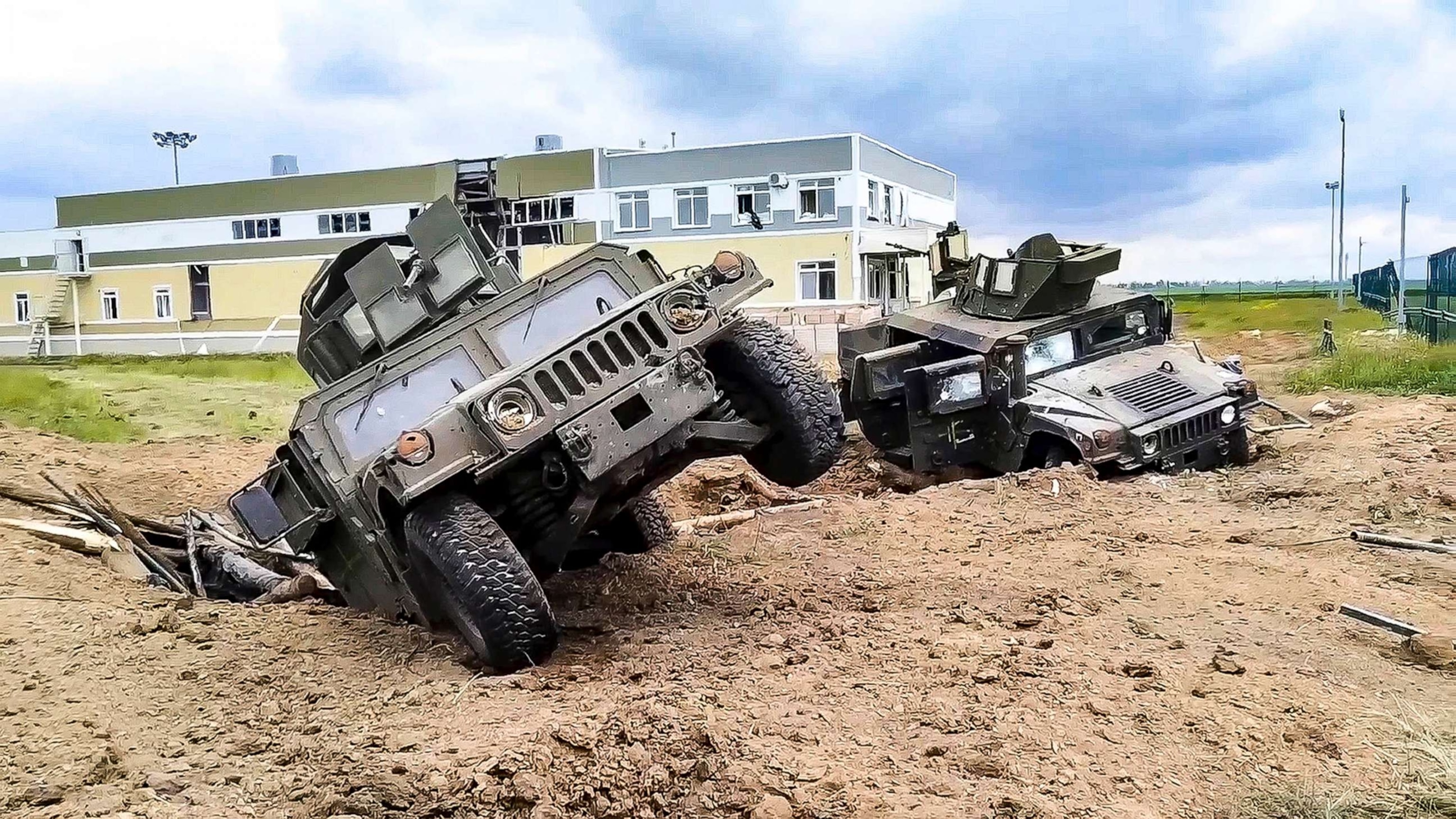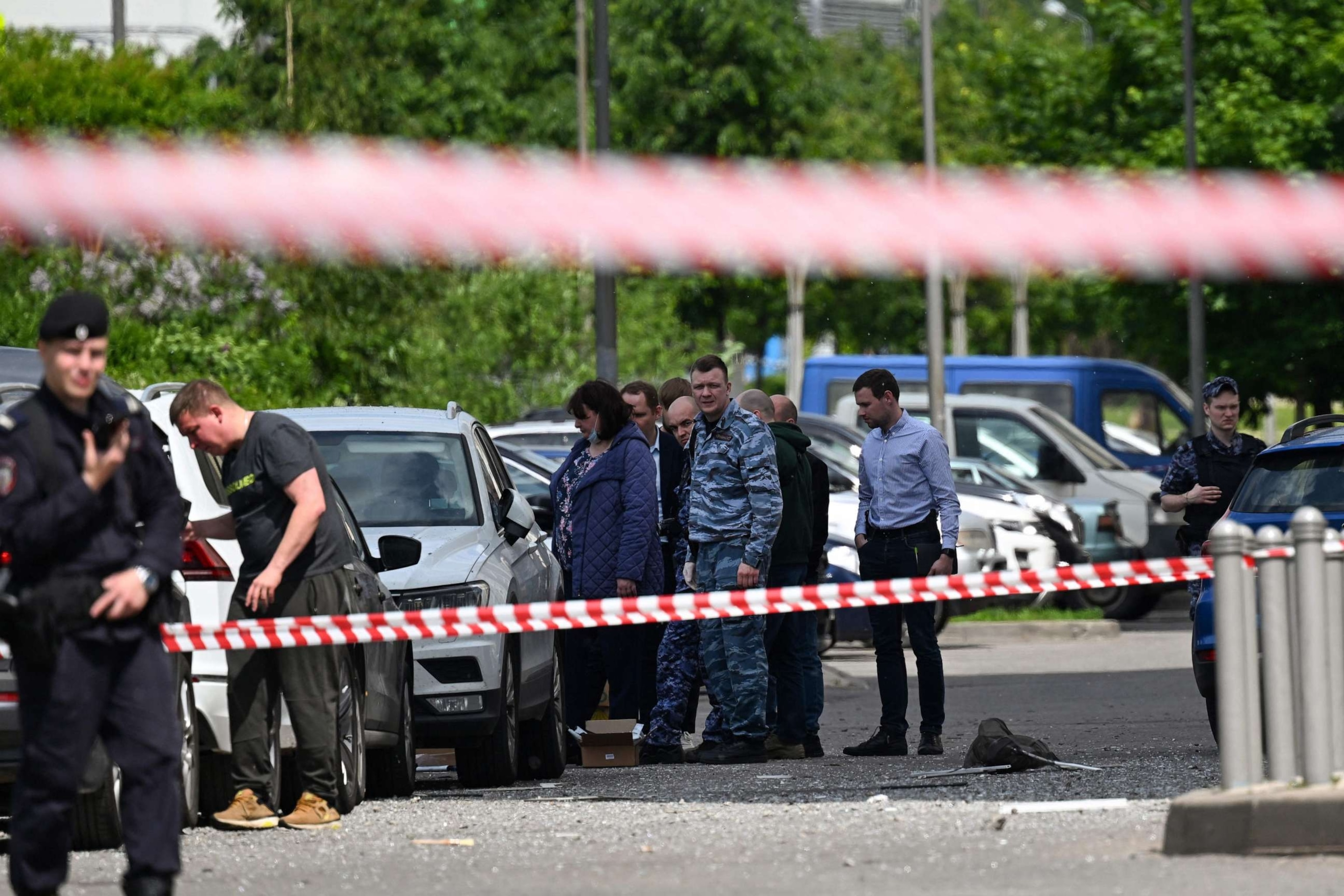Are US arms sent to Ukraine being tracked so they can't be used for attacks in Russia?
After recent incidents, the White House warned it could cause "World War III."
Paramilitary organizations making the largest cross-border attack inside Russia since the war began have maintained they're fighting for Ukraine and reportedly claimed to have conducted another operation Thursday.
But more than a week after verified images appeared to show that the fighters were equipped with U.S.-supplied military vehicles in their initial incursion, the Biden administration has yet to say whether the groups are formally fighting in coordination with Kyiv.
The incidents raise questions about whether they put at risk the main U.S. strategic goal of avoiding escalation with Moscow -- "World War III" as the White House has warned -- and they come just when the conflict appears poised to intensity with Ukraine's long-awaited spring offensive.
And, they raise practical concerns about whether that goal could be undermined given questions about how well the U.S. keeps track of the billions in arms and equipment it has sent to Ukraine.
Any assessment from Washington on whether the groups are operating within the Ukrainian government's chain of command could have significant impact in determining whether any end-use violation or breach of agreement occurred if the fighters were given access to the equipment or pave the way for Kyiv to openly outfit the fighters with donated weaponry, while the persisting lack of clarity raises questions about how effectively these arms are monitored.

Gaps in monitoring, potential for escalation
When pictures surfaced appearing to show U.S.-manufactured Humvees and MRAP armored vehicles used in the Belgorod incursion, the administration initially showed strong skepticism. But after the photographic evidence was vetted by various major media organizations, officials promised to investigate.
"We're looking into those reports that the U.S. equipment and vehicles could have been involved," White House spokesperson John Kirby told reporters.
Asked on Thursday about the status of that investigation, a State Department spokesperson said there were no updates to share.
The Ukrainian government has denied playing any part in the first wave of raids on Belgorod, which were carried out by groups made up of anti-Kremlin Russian nationals known as the Free Russia Legion and the Russian Volunteer Corps, the latter of which has been linked to neo-Nazi sentiments.
On Thursday, the pro-Ukrainian militants appeared to shell towns in Belgorod, prompting a partial evacuation of civilians from the area. While the groups seemed to be heavily armed with sophisticated weaponry, there were no immediate signs that American arms were used in the attacks.
Although U.S. officials have not publicly characterized Ukraine’s role in the incursions, they have repeatedly said that the U.S. does not support attacks on Russian territory.
"We have been very clear with the Ukrainians privately, we certainly have been clear publicly, that we do not support attacks inside Russia," Kirby said on Wednesday, after announcing the latest drawdown of equipment for Ukraine in the White House briefing room. "We certainly don't want to see attacks inside Russia that are, that are being propagated, that are being conducted, using US-supplied equipment."
Kirby said that stance was rooted in the president's goal to "avoid World War III."
"I think we can all agree that a war that escalates beyond that -- that actually does suck in the West and NATO and the United States is not only not good for our national security interest, it is not good for the Ukrainian people," he said.
Beyond close coordination with the Ukrainian government, U.S. officials have touted close monitoring of military aid shipped to Ukraine. But their flip-flopping on the possibility that some of the armored fighting vehicles used in Belgorod could have been supplied to Ukraine by Washington and their inability to provide any conclusions after a week has opened the Biden administration up to criticism.
Republicans have zeroed in on accountability but have largely centered their focus on avoiding waste rather than preventing escalation.
"I do not conduct this oversight to undermine or question the importance of support for Ukraine, but rather -- to the contrary -- oversight should incentivize the administration and Ukraine to use funds from Congress with the highest degree of efficiency and effectiveness," House Foreign Affairs Committee Chairman Michael McCaul, R-Texas, said at a hearing in late March.
While the Department of Defense's top watchdog testified during that hearing that he had not seen any illicit diversion of the over $20 billion worth of American weapons and other military equipment provided to Ukraine, previous reports have indicated that only around 10% of high-risk munitions have been inspected by U.S. monitors and only a handful of the weapons are legally subject to enhanced end-use tracking.

Defense officials have also noted that carrying out oversight in an active war zone with a very limited American footprint comes with challenges and potential blind spots. Ukraine's history of past corruption has also stoked some unease across Washington.
State Department spokesperson Matthew Miller was asked last Thursday whether the time that had elapsed in the investigation into the incident raised red flags for the administration regarding the effectiveness of its tracking measures.
"No, I think it raises the fact that we are looking into it and haven't yet reached a conclusion," he responded.
One way that the U.S. tracks sensitive items to Ukraine is by the placement of barcodes on each item that contain unique identifying information, such as serial numbers, and by providing Ukraine with ways to track the equipment it has been given by the U.S.
Ukraine keeps stock of its Humvees and MRAP armored vehicles, and regularly reports battlefield losses to American officials.
ABC News reached out to Ukraine's Ministry of Foreign Affairs and a member of Ukraine's parliament seated on a committee charged with monitoring weapons supplied by foreign governments but did not receive a response.
A shortfall in tracking weapons
Despite the administration's apparent hesitancy to draw firm conclusions, experts closely studying the conflict say some key answers are obvious.
"It is a shortfall in tracking of weapons and munitions," Mark Cancian, a senior adviser for the Center for Strategic and International Studies' International Security Program, said. "War is complicated -- there is no guarantee that weapons will not be used in ways that we don't approve, and this is clearly one of them."
"It would strain credulity to me to think there is not command control here from Kyiv—or at least from Ukrainian military intelligence," said John Hardie, the director of the Foundation for Defense of Democracies' Russia program.
Cancian echoed that conclusion, adding that any disconnects within Ukraine's military could present serious problems.
"It's not impossible that there are fractures within the Ukrainian government. If that's the case, it is quite disturbing -- because that means that the Ukrainians are not in full control of military forces on their territory," he said. "It opens the possibility of what we're seeing in Russia, where you have militias that are acting independently and confronting even in some ways undermining the central government."
Cancian says that repeated incidents of American military gear surfacing in the hands of paramilitary groups would be telling.
"If this happens again, then it's not just happenstance -- it's a pattern. And that would indicate that they have not been able to get control," he said.
Or, Hardie posited, the Biden administration could seek to allow Ukraine to leverage ambiguous attacks on Russia while publicly standing by its policy against such actions.
"Perhaps U.S. officials look the other way," Hardie said.
Beyond Belgorod, apartment buildings in the heart of Russia's capital were the target of a drone strike on Tuesday. Though Ukrainian authorities did not take responsibility, the country's officials have not masked their pleasure.
"If the Russians can make Kyiv a nightmare, why do the people of Moscow rest?" Vitali Klitschko, the mayor of Kyiv, said in a televised address following the strike.

While the spike in attacks waged by Ukraine on Russia drastically pales in comparison to those waged on Ukraine by Russia through the course its 15-monthlong invasion, Kyiv has much more to lose in terms of public opinion since its war efforts depend on support from dozens of allies who largely see the country as a besieged victim rather than a tit-for-tat combatant.
Conversely, by bringing the war full circle, strikes into Russia might erode its population's support for the Kremlin -- something some indicators show has already been happening in recent weeks.
So far, the Biden administration appears to be sticking to an increasingly familiar strategy.
"We're still trying to get information here and develop some sort of sense of what happened," Kirby said when asked about the Moscow drone strikes on Wednesday.
ABC's Matthew Seyler and Molly Nagle contributed to this report.




